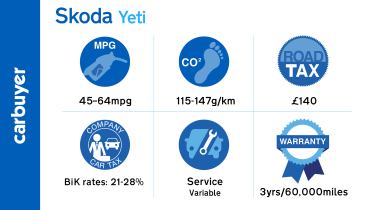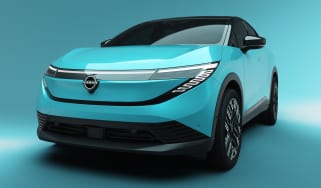Skoda Yeti SUV (2009-2017) - MPG, running costs & CO2
Reasonably good in this area, but the Skoda Yeti is starting to lag behind rivals when it comes to fuel economy and emissions
The Skoda Yeti is a cheap car to run as well as a relative bargain to buy. All engine combinations are reasonably economical, with sensible CO2 emissions, too.
Our favourite combination for low running costs and reasonable power is the 109bhp 2.0-litre diesel in front-wheel-drive form. It can manage over 60mpg and feels fairly quick at the same time.
Skoda Yeti MPG & CO2
The 1.2-litre TSI petrol engine and the 109bhp 2.0-litre TDI diesel engine with two-wheel drive are the best-selling combinations, with CO2 emissions of 128g/km and 118g/km placing the Yeti in the 24 and 25% Benefit-in-Kind brackets for company-car drivers. Both engines are turbocharged and neither has any trouble keeping pace with motorway traffic.
You can choose Skoda’s DSG automatic transmission with most engine and trim combinations. It's a smooth gearbox and fuel economy doesn't suffer with it fitted; in fact there are few more efficient automatic gearboxes on the market. The Yeti 1.4-litre TSI manages just 44.8mpg, because it's only available with four-wheel drive. All Yetis will attract road tax of £140 a year.
The 148bhp 2.0-litre TDI diesel returns with four-wheel drive returns 55.4mpg, which is far from poor. It should be noted that the 2.0-litre diesel engines will require occasional top-ups of AdBlue. This is a fluid that acts in the car’s exhaust system to remove pollutants and help the car to meet Euro 6 emission standards.
Insurance group
The lowest insurance rating is group 14, enjoyed by the Yeti S when equipped with a 109bhp diesel engine. Most other models sit in insurance group 15, although some versions with the most powerful 148bhp petrol or diesel engine fall into groups 21 and 22.
Warranty
The Skoda warranty lasts for three years, with unlimited mileage in the first two years but the third year capped to a maximum of 60,000 miles. You can extend this warranty to a four-year/80,000-mile policy for an additional £300, or five years/100,000 miles for £630.
While Skoda offers a three-year/60,000-mile warranty as standard, certain rivals are far more generous. Hyundai, for example, gives a five-year warranty, whilst every Kia has a seven-year policy as part of the deal. For a company with such a good reputation for quality and reliability, Skoda could probably offer a longer warranty.
Servicing
Skoda offers a service plan to cover the first two services at a cost of £279. For most customers, the standard fixed-interval regime will be the most suitable. The car is serviced once every year or at 10,000 miles. This suits anyone who covers a low yearly mileage or does a lot of short, stop-start journeys where the car is subjected to a lot of acceleration and braking before it warms up.
If your yearly mileage is likely to be a lot more or if you do a lot of motorway journeys where the car cruises at high speeds, your best option may be the variable service interval regime. Here, the car will automatically determine when a service is due using built-in wear sensors. The intervals can then come anywhere between 9,000 and 20,000 miles, but never more than two years apart.













